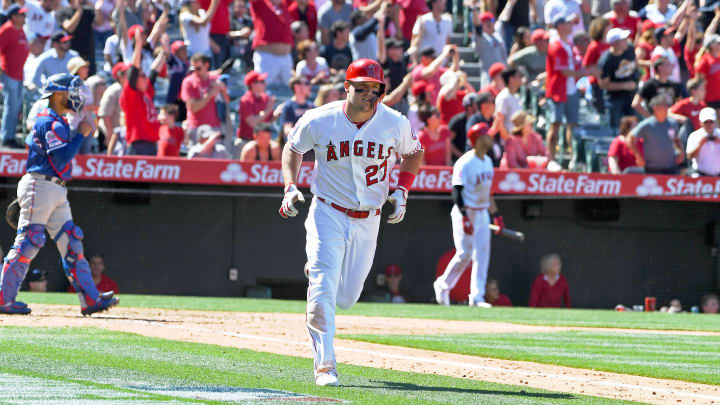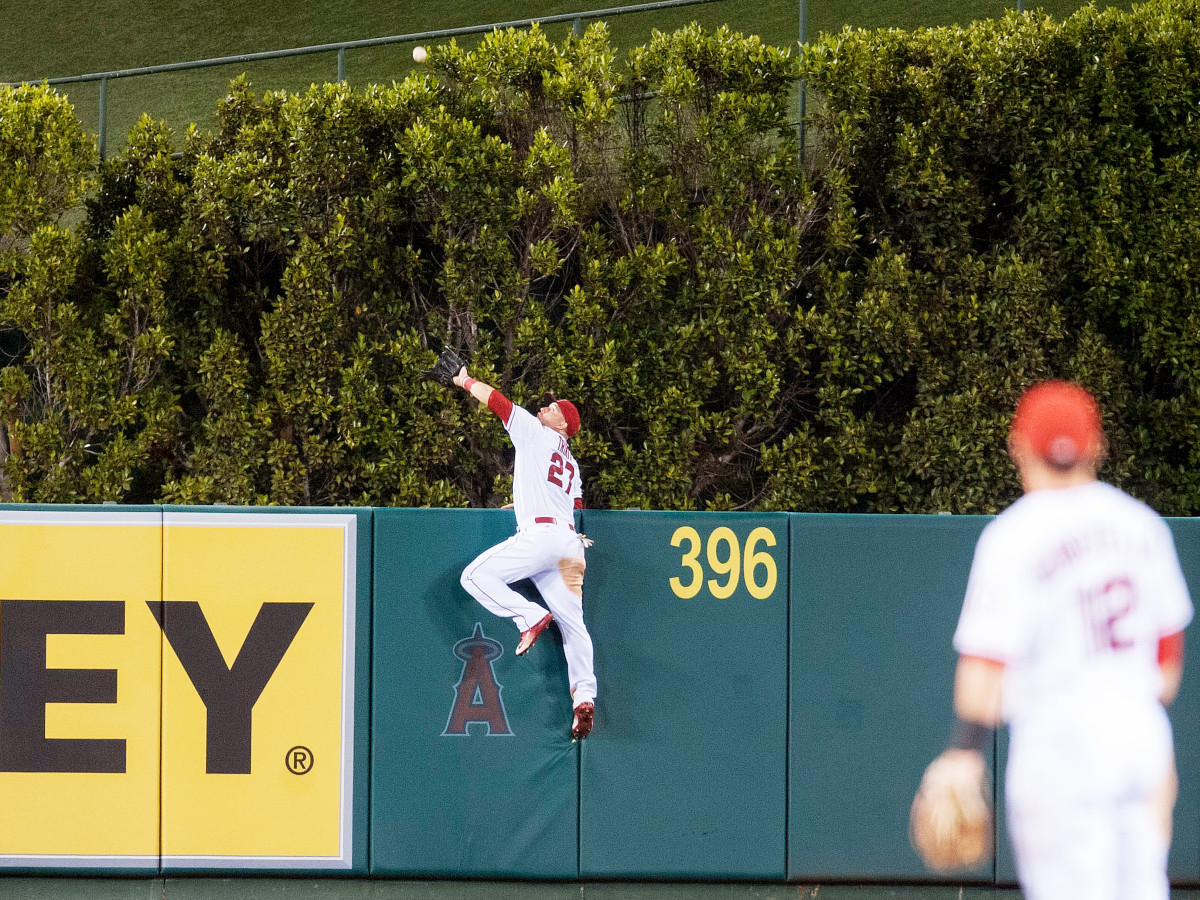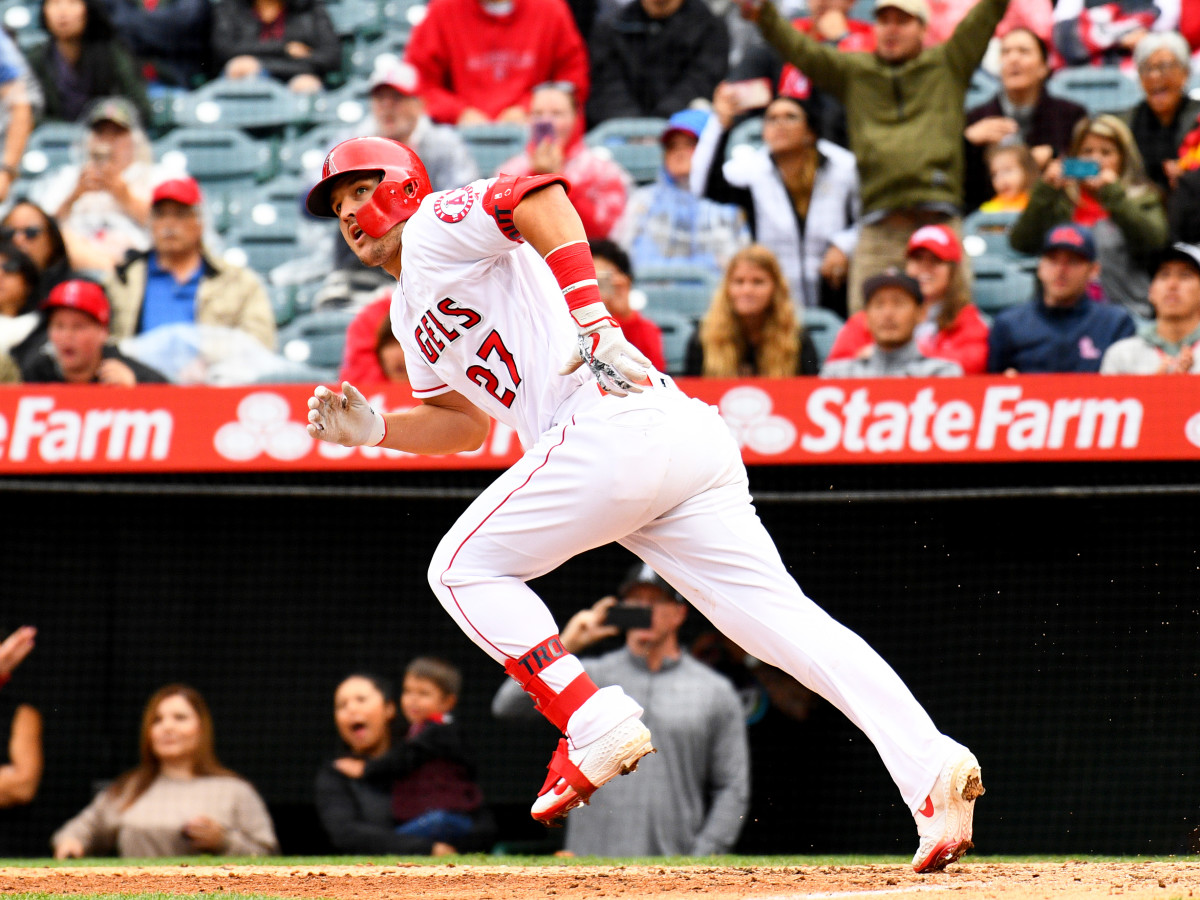Ranking Mike Trout's Eight Seasons From Great to Greatest

It’s a question best suited for philosophers, or perhaps the realm of theoretical physics: Can the best player in baseball get even better? Over nine years, Mike Trout has put up the kind of seasons that mark him as baseball royalty, as the elite of the elite. In all of them—save his abbreviated 2011 stay—he has produced absurd numbers. The worst Trout year would still rank among the best for any player in league history: His lowest full-season Wins Above Replacement total (7.6) would represent the best mark of Chipper Jones’ 19-year career, as well as those of Tim Raines, Buster Posey and Jim Thome. But amid a career that’s already Hall of Fame caliber, 2019 may be his magnum opus, as he’s destroying all competition en route to what will likely be his third AL MVP award.
Will this year be Trout’s best as a big leaguer though? In what is sure to be a highly non-controversial piece, I’ve taken my best stab at ranking the eight seasons (not including his brief 2011) of his career from worst to best. Join me on a voyage of discovery and awe.
8. 2014 (age 22)
157 G, 705 PA, 115 R, 173 H, 39 2B, 9 3B, 36 HR, 111 RBI, 16 SB (2 CS), 83 BB, 184 K, .287/.377/.561, 168 OPS+, 6 GDP, 6 IBB, 7.6 bWAR
All-Star, Silver Slugger, MVP
It feels weird to say this about an MVP-winning year, but 2014 is easily Trout’s worst full season as a major leaguer. It featured his highest strikeout total (and also the highest in the league) and lowest full-season WAR figure. He stole only 16 bases after swiping a combined 82 in his first two seasons. His walk rate plummeted to the second-worst mark of his entire career. He couldn’t figure out fastballs, slugging a paltry-for-him .507 against them. And overall, 2014 featured his worst batting average, on-base percentage and OPS+ figures.
Yet oddly enough, despite being a down year in the stats, it was arguably the most productive professional season of Trout’s entire career in terms of personal accomplishment. Beyond the aforementioned MVP award—unanimous, no less—Trout set a career high in homers, RBI and total bases, won All-Star Game MVP honors, and signed a six-year, $144.5 million extension that spring. On top of that, the Angels posted the best record in the AL, won their division, and made the playoffs for the first (and so far only) time in his career. May we all be so lucky that our worst years are this great. Still, this is a no-brainer choice for last place.
7. 2013 (21)
157 G, 716 PA, 109 R, 190 H, 39 2B, 9 3B, 27 HR, 97 RBI, 33 SB (7 CS), 110 BB, 136 K, .323/.432/.557, 179 OPS+, 8 GDP, 10 IBB, 9.0 bWAR
All-Star, Silver Slugger, MVP-2 (Miguel Cabrera)
On the surface, Trout’s 2013 looks like one of his best, but it’s marred by some wonkiness under the hood. The good: His walk rate jumped significantly from 2012, ranking as the third highest in the league, and he became only the seventh player ever to record 100 or more walks in a season at age 21 or younger and just the second to lead the league in the category at that age. But despite more games and plate appearances than his rookie year, he hit fewer homers and stole fewer bases (and posted a lower success rate). Worse, a downturn in defense dropped his WAR. Some of that was likely due to a worse outfield around him—he went from the peerless Torii Hunter and the acceptable Vernon Wells in 2012 to the awful Josh Hamilton and the below-average J.B. Shuck and Kole Calhoun—but he also made fewer plays in more chances, per FanGraphs’ Inside Edge stats.
It’s unfair to judge Trout based on single-season defensive stats, and it doesn’t take away from the fact that he was hitting like Peak Mickey Mantle at age 21 (and once again deserved MVP honors, only to lose them once again to Miguel Cabrera in his Triple Crown year). Nonetheless, the dip in defense, steals and power make this a year that ranks near the bottom of his personal best. And yes, I’m putting a 9-WAR season seventh. That should say a lot about what awaits at the top.

6. 2015 (23)
159 G, 682 PA, 104 R, 172 H, 32 2B, 6 3B, 41 HR, 90 RBI, 11 SB (7 CS), 92 BB, 158 K, .299/.402/.590, 176 OPS+, 11 GDP, 14 IBB, 9.4 bWAR
All-Star, Silver Slugger, MVP-2 (Josh Donaldson)
Perhaps the most impressive if not terrifying thing about Trout is the seeming ease at which he identifies and corrects the flaws in his game. His 2014 season was full of them: too many strikeouts, weak defensive numbers, a drop in steals, an inability to deal with high fastballs (the only hole that the league had so far found in his swing, and one ruthlessly targeted). Trout knew all that, and he came into ’15 determined to do better.
Frighteningly, he did just that. Though he wasn’t able to run more (and was only successful 61.1% of the time), Trout set a new career high in homers, slugging percentage and OPS+. His strikeout rate remained high at 23.2%, but that was a big drop from the year prior’s ghastly 26.1. His walk rate ticked upward after falling dramatically between ’13 and ’14. The kryptonite that was high fastballs was destroyed, as he slugged .724 with 36 homers on heaters. The 2015 season was the first in which we have Statcast data to peruse, and it shows a version of Trout who was absolutely clobbering the ball, with career-high marks in hard-hit rate (48.6%) and average exit velocity (92.9 mph). He did all of that, too, despite suffering through one of the worst months of his career, an August in which he went deep only once and put up a .689 OPS thanks to a wrist injury suffered at the end of July.
The defensive change, though, is what makes you sit up and take notice. In 2014, Trout’s arm ranked as one of the worst in the game per FanGraphs’ UZR Arm stat. The relative weakness of Trout’s throws had long stood out as one of the few flaws in his makeup. So he worked on it through 2014 and into ‘15, refining his mechanics and long-tossing to build up strength. Within the span of a year, his throwing went from a negative to slightly above average. That’s an astonishing improvement in just 12 months—and proof that seemingly nothing is beyond Trout.
So why is this season all the way down at No. 6? Simply put: better somehow lies ahead.
5. 2016 (24)
159 G, 681 PA, 123 R, 173 H, 32 2B, 5 3B, 29 HR, 100 RBI, 30 SB (7 CS), 116 BB, 137 K, .315/.441/.550, 172 OPS+, 5 GDP, 12 IBB, 10.5 bWAR
All-Star, Silver Slugger, MVP
There’s a part of every montage in every sports movie where, after trying and failing and struggling, the main character or plucky underdog team starts to improve. It’s visible, too: The punches land with more ferocity, the shooting becomes better, the defense gets crisper. Over time, the zero turns into a hero. (Not that Trout was ever a zero, but you get what I mean.)
For Trout, 2016 is that demarcation point—the moment when the chemicals mixed together in the test tube and changed color. His walk rate skyrocketed all the way up to 17.0%, second highest in the majors (a fraction behind Bryce Harper’s 17.3). He started stealing bases again, collecting more this season than in the previous two years combined. Scariest for pitchers is that ’16 was a turning point for Trout’s control of the strike zone: His zone-swing rate hit a new high of 60.3%, and it hasn’t dipped below 59% since. Famously reluctant to swing (particularly at first pitches), Trout began to attack more. As with his mastery of high fastballs, he closed off yet another potential avenue of exploitation for opposing pitchers.
Still, this season isn’t all roses. Despite 2016 being a historic year for homers, Trout hit only 29, his second-lowest career total. His ground-ball rate jumped, as he posted a groundball-to-flyball ratio above 1.00 for the first time since 2013 (and the last time ever), and his launch angle dipped to a career-low 12.9 degrees. While everyone aimed for the sky, Trout beat balls into the dirt, robbing him of the kind of sterling power numbers that would’ve made this a truly world-class season.
Still, it’s hard to argue against a league-leading 172 OPS+ or the 10.5 bWAR that’s tied with his rookie season for his best ever. For that, he won his second MVP award, edging out Mookie Betts. It was well deserved, but because of that strange power outage, this isn’t top three in his personal pantheon.

4. 2017 (25)
114 G, 507 PA, 92 R, 123 H, 25 2B, 3 3B, 33 HR, 72 RBI, 22 SB (4 CS), 94 BB, 90 K, .306/.442/.629, 186 OPS+, 8 GDP, 15 IBB, 6.6 bWAR
All-Star, MVP-4 (Jose Altuve)
Weep, if you can, for greatness cut short. If it weren’t for a torn thumb ligament suffered on a headfirst slide at the end of May that cost him 40 games, 2017 probably would have gone down as Trout’s greatest campaign to date. He posted his best strikeout rate (17.8%). His walk rate went up for a fourth straight season and was the third highest in baseball. He finally cracked the .600 mark in slugging percentage as his power surged thanks to a big jump in fly-ball rate and launch angle. The greatest hitter alive figured out the best possible thing he could: groundballs suck, and you should hit as few of them as you can. Had he stayed healthy, Trout likely would have challenged for the first 50–30 season in MLB history. It’s not without reason that multiple writers (myself included) wondered that year whether Trout had somehow found a new, unimaginably high level for himself.
Alas, we can only dream. But for all we lost, the gains were visible—none more notable than his career-low rates in outside-zone and swinging-strike percentage, as well as an increase in contact rates. Coupled with the growth in flyball rate, the stage was set for Trout to do what was believed impossible: get better.
3. 2012 (20)
139 G, 639 PA, 129 R, 182 H, 27 2B, 8 3B, 30 HR, 83 RBI, 49 SB (5 CS), 67 BB, 139 K, .326/.399/.564, 168 OPS+, 7 GDP, 4 IBB, 10.5 bWAR
AL Rookie of the Year, All-Star, Silver Slugger, MVP-2 (Miguel Cabrera)
As far as debuts go, Trout’s 2012 campaign is arguably the best ever. Those gaudy numbers above would be phenomenal for someone 10 years Trout’s senior, much less for a kid who turned 21 that August. In fact, his 168 OPS+ is the highest ever in the modern era by a player in his age-20 season or younger who qualified for the batting title. (Only Cap Anson’s 200 tops Trout, and that came across 46 games in 1872.) Likewise, by bWAR, it’s the best age-20 season ever, with Trout’s 10.5 topping Alex Rodriguez’s previously record-setting 9.4 in 1996. (They’re the only two under-20 players ever to crack 9.0 WAR in a season.) That’s also still his best WAR finish in his career, tied with 2016, and it was a whopping two wins better than second-place Robinson Cano.
Even without the age qualifiers, though, Trout’s 2012 still stands as one of his most impressive years. It’s still tops in his career for batting average and stolen bases, the latter of which includes a 90.7% success rate that’s the seventh-best mark in MLB history, minimum 50 attempts. The 129 runs are also a career best. That deservedly (and easily) won him AL Rookie of the Year honors, but he fell short in the MVP voting to Cabrera despite Trout’s superlative baserunning and defense (or at least, relative to Cabrera’s non-existent baserunning and defense).
That battle between the two over the soul and future of baseball played out to similar results in 2013, but between those campaigns, this is the more impressive one. Perhaps the most amazing thing is that Trout somehow managed to get better despite starting from such great heights.
Mike Trout sets a career-high with his 42nd HR on the season! pic.twitter.com/YTixmZ7iaw
— Los Angeles Angels (@Angels) August 20, 2019
2. 2019 (27)
125 G, 563 PA, 103 R, 130 H, 27 2B, 2 3B, 42 HR, 99 RBI, 10 SB (2 CS), 101 BB, 112 K, .293/.437/.648, 183 OPS+, 5 GDP, 12 IBB, 8.0 bWAR
All-Star
By virtue of this season not having ended, I can’t put it first. Trout could roll out of bed tomorrow and break his foot, or he could be abducted by aliens, or he could suddenly retire and disappear to a farm in the middle of the country and lead a quiet life raising cattle, turning away strangers who come by and say, “Hey, you look like that Mike Trout fella,” with a small smile and a quiet, “Yeah, I get that a lot.” (I wrote this before Andrew Luck shockingly retired from the NFL on Saturday night.) Much and more could happen between now and the end of September.
But if his current pace continues, then 2019 has a strong case to become No. 1 with a bullet. He’s already set a career high in homers with 30 games to go in the season and is showing more power than years previous. Some of that is the juiced ball, no doubt, but it’s also a result of Trout hitting more flyballs than ever before at his highest launch angle ever. By WAR, this will be his fourth season with 10-plus (!) and has an outside chance of being his top finish ever. The gap between him atop the AL WAR leaderboard and the No. 2 player, Alex Bregman at 6.3. And all the defensive metrics have this as one of his best seasons ever in centerfield.
You can quibble with Trout once again not stealing bases after swiping 46 in the prior two years combined, or that he’s had years with higher walk rates or better contact. But with the possible exception of the top season on this list, he’s never put everything together as well as he has this year.
1. 2018 (26)
140 G, 608 PA, 101 R, 147 H, 24 2B, 4 3B, 39 HR, 79 RBI, 24 SB (2 CS), 122 BB, 124 K, .312/.460/.628, 196 OPS+, 5 GDP, 25 IBB, 10.2 bWAR
All-Star, Silver Slugger, MVP-2 (Mookie Betts)
This is the top of Mount Olympus. All the improvements Trout made in 2017 carried over to ’18, most importantly the continued increase in flyballs, walk rate and contact rate. His 20.1% walk rate was far and away tops in baseball, leading to a career-best OBP and walk total. His defense was Gold Glove-caliber. He continued to be hyperactive on the bases, getting caught just twice in 26 tries. He grounded into only five double plays out of 231 plate appearances with runners on, or a rate of just 2.2%. Everywhere you look, you find brilliance, except for his RBI total, and if you care about that when it comes to Trout, then I hate you.
It wasn’t enough to win Trout MVP honors, because somehow it never is. (That’s to take nothing away from Betts, who put up a Herculean year.) But this is unassailable greatness—and he did this in 140 games after missing two-plus weeks with a wrist injury. He was almost 100% better than the league average on offense. If you let that thought float around your brain, it will shut down most of your higher functions so that you can appreciate it more fully.
There are two things that stand out to me most from Trout’s 2018. The first is that, at 10.2 WAR, it’s not his best season by that stat. The second is that, when 2019 is said and done, this colossal year may not be No. 1 any longer.
